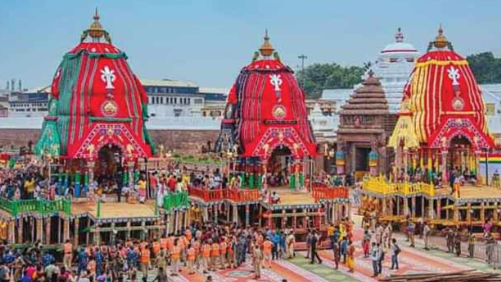

Bhubaneswar, Odisha - As the monsoon clouds gather over the sacred city of Puri, millions of devotees prepare for one of the world's most spectacular religious processions. The Rath Yatra of Lord Jagannath is not just a festival—it's a living testament to faith that has endured for centuries, carrying within its ancient wheels secrets that continue to mystify scholars and devotees alike.
The history of Puri Jagannath temple and Puri Ratha Yatra have been intertwined since the construction of the temple building in the 12th century, making this grand celebration approximately 800-900 years old. However, some sources suggest the Rath Yatra History dates back to over 5,000 years ago in Jagannath Puri, connecting it to the ancient Krishna legends.
Having been mentioned in ancient scriptures such as Brahma Purana, Padma Purana, and many more, the tradition of Rath Yatra in Puri is approximately 460 years old in its current organized form, though the spiritual essence reaches back to the very foundations of Hindu tradition.
The emotional connection Odias share with their beloved Jagannath runs deeper than religious devotion—it's woven into their very identity.
Biswanath Rath, a 68-year-old retired school teacher from Cuttack, reflects on his lifelong bond: "I have attended Rath Yatra for over five decades. For us, Jagannath is not just a deity—he is our elder brother, our protector. When I see those massive chariots moving, I feel like I'm witnessing the heartbeat of Odisha itself."
Sujata Panda, a homemaker from Bhubaneswar, shares her annual pilgrimage experience: "Every year, my entire family travels to Puri. My grandmother used to say that if you can't go to Jagannath, Jagannath will come to you. During Rath Yatra, he steps out of his temple to bless everyone, regardless of caste or creed. That's the beauty of our tradition."
Ravi Mohanty, a young software engineer working in Bangalore but originally from Kendrapara, expresses the diaspora connection: "No matter where I am in the world, Rath Yatra reminds me of my roots. I stream the live telecast and feel that emotional pull. Jagannath is not confined to Puri—he travels in our hearts wherever we go."
The Rath Yatra holds numerous secrets that even regular devotees might not know:
The English Connection: The British, during their rule in India, were utterly captivated by the splendour and fervour of the Puri Rath Yatra. They were so mesmerized by the spectacle that they coined a term to encapsulate its grandeur – "Juggernaut." This word, now common in English, literally means an unstoppable force.
Artisan Marvel: Every year 200 artisans work for 2 months to make the rath of Puri Rath Yatra. These skilled craftsmen use traditional tools and techniques passed down through generations, creating chariots without using a single nail.
The World's Largest Kitchen: The kitchen located in Jagannath Puri is believed to be the largest in the world, with 56 dishes cooked every day and food prasad distributed to 2,000 to 200,000 people. The temple's culinary operation is so vast it could feed a small city.
Eco-Friendly Tradition: At the end of the festival, the chariots are broken, and their wood is used as fuel in the temple kitchen. This ancient practice embodies sustainable principles that modern environmentalists advocate.
Global Recognition: Rath Yatra, Puri, at Puri in the state of Odisha, is the largest and most visited Ratha Yatra in the world, attracting devotees from every corner of the globe.
Padma Lochan Panda, a respected Sanskrit scholar and temple priest, explains the deeper meaning: "Rath Yatra symbolizes the soul's journey toward liberation. When Lord Jagannath leaves his ornate temple to ride in a simple wooden chariot, he teaches us about humility and accessibility. The divine descends to the level of common people."
The festival represents a unique aspect of Hindu philosophy where the deity becomes approachable. Jagannath Rath Yatra symbolises the journey of Lord Shri Krishna from Dwaraka, connecting the celebration to one of Hinduism's most beloved epics.
For Odias worldwide, Rath Yatra transcends religious boundaries to become a celebration of cultural identity. The festival brings together people from all walks of life, creating a temporary city of faith where social barriers dissolve.
Dr. Chitrasen Pasayat, a cultural anthropologist from Utkal University, observes: "Rath Yatra is perhaps the only festival where the deity travels to meet the people rather than people traveling to meet the deity. This reversal of traditional religious protocol makes it profoundly democratic and inclusive."
The chariots themselves—Nandighosa for Jagannath, Taladhwaja for Balabhadra, and Darpadalana for Subhadra—are engineering marvels built entirely from wood and rope, representing the triumph of traditional craftsmanship over modern technology.
As the ancient chariots roll through Puri's streets each year, they carry forward a tradition that has survived invasions, colonial rule, and modernization. The Rath Yatra stands as a testament to the enduring power of faith and the unbreakable bond between a people and their beloved deity.
In the words of countless devotees who line the Grand Road, "Jagannatha Swami Nayana Pathagami Bhavatu Me"—may Lord Jagannath be the object of my vision. This prayer, echoing through centuries, continues to draw millions to witness the most magnificent spiritual journey on Earth.